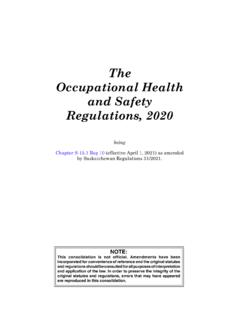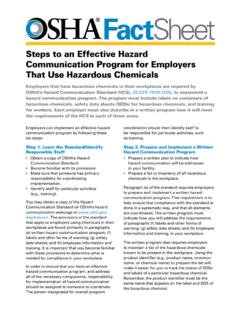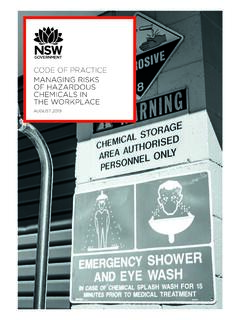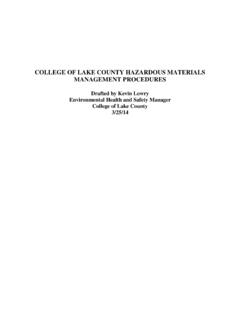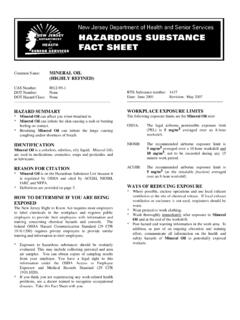Transcription of Workplace Health and Safety Manual
1 Western North Carolina Workers Center w w w . w n c w o r k e r s c e n t e r . o r g 1st Edition Workplace Health and Safety Manual OSHA Funding for this Workplace Health and Safety Manual was provided under grant SH-27638-SH5 from the Department of Labor, Occupational Safety and Health Administration (OSHA), Susan Harwood Grant program. The Manual s contents do not necessarily reflect the view or policies of the of Labor, nor does the mention of trade names, commercial products, or organizations imply endorsement by the Government. It is not possible to include discussion of everything necessary to ensure a Health and safe working environment in a Manual of this nature.
2 Thus, this information must be understood as a tool for addressing Workplace hazards, rather than an exhaustive statement of an employer s legal obligations, which are defined by statute, regulations, and standards. Likewise, to the extent that this information references practices or procedures that may enhance Health or Safety , but which are not required by a statue, regulation, or standard, it cannot, and does not, create additional legal obligations. Finally over time, OSHA rules and interpretations may be modified in light of new technology, information , or circumstances; to keep apprised of such developments, or to review information on a wide range of occupational Safety and Health topics, visit OSHA s website at The Small Group Activity Method Basic Structure The Small Group Activity Method is based on activities.
3 An activity can take from 45 minutes to an hour. Each Activity has a common basic structure: Small Group Tasks Report-Back Summary Small Group Tasks: Activities include tasks (problems), or sets of tasks, for the groups to work on. Each tasks asks that groups use their experience and the factsheets to solve problems and make judgments on key issues. Report-Back: For each task, groups select scribes that take notes on the small group discussions and report back to the class as a whole. During the report-back the scribe informs the entire class as to how his or her group solved the particular problem. The trainer records each scribes report-back on large pads of paper in front of the class so that everyone can refer to them. Summary: Before the discussion drifts too far, the trainer needs to bring it all together during the summary.
4 Here, the trainer highlights the key points of the Activity and brings up any problems or points that may have been overlooked during the report-back. Three Basic Learning Exchanges The Small Group Activity Method is based on the idea that every training is a space where learning is shared. With SGAM, learning is not a one-way street that runs from trainer to worker. Rather, SGAM is a structured procedure that allows us to share information . It is based on three learning exchanges: Worker-to-Worker Worker-to-Trainer Trainer-to-Worker Worker-to-Worker: Most of learn best from each other. SGAM is structured so that the worker-to-worker exchange is a key element of the training. The worker-to-worker exchange allows participants to learn from each other by solving problems in their small groups.
5 Worker-to-Trainer: Lecture-style training assumes that the trainer knows all the answers. With SGAM it is understood that the trainers also have a lot to learn and this is the purpose of the worker-to-trainer exchange. It occurs during the report-back and it is designed to give the trainer an opportunity to learn from the participants. Trainer-to-Worker: This is the trainer s opportunity to clear up confusion and make points they think are key. By waiting until the summary section, trainers know better what people need to know. OSHA Rights and Responsibilities Purpose To learn more about worker/employer rights and responsibilities under OSHA and how we can use OSHA as a tool for eliminating hazards in our workplaces. This Activity has two tasks. Task 1 Your group has been asked to make a presentation to a group of poultry processing workers regarding their rights and responsibilities under OSHA.
6 Review the factsheets on the following pages, then working together make a list of key points you will make during the presentation. (Try to support each point with a factsheet) OSHA Rights and Responsibilities Key Point: (Please make a list) 1. 2. 3. 4. 5. 6. 7. After you have completed your presentation please answer the following questions.: 1. Have you or your co-workers used OSHA in the past? If yes, what happened? (Briefly explain the situation and the outcome) If no, have you been involved in situations where you thought about filing an OSHA complaint? (Briefly explain the situation and why you decided not to call) 2. Are there hazards in the Workplace right now that you think need to be eliminated? If yes, based on your experiences would it make sense to file an OSHA complaint?
7 (Please explain) 3. If your opinion if more workers knew about their rights would they use OSHA to make their jobs safer? (Please explain) 1. What is OSHA and Who Is Covered? The Occupational Safety and Health Administration (OSHA), is an agency of the Department of Labor. Congress created OSHA under the Occupational Safety and Health Act of 1970. Prior to 1970, no uniform, comprehensive provisions existed to protect workers against unsafe or hazardous work situations. OSHA s sole responsibility is to develop mandatory job Safety and Health standards and enforce them through Workplace inspections, employer assistance, and by imposing citations and financial penalties. OSHA covers all private sector employers and employees, including poultry processing workers as well as workers employed in construction, agriculture, housekeeping among other sectors.
8 Sources: Department of Labor, Occupational Safety and Health Administration, OSHA 2056, All About OSHA, 2000 (Revised) and OSHA Workers Rights 3021-09R 2011. 2. Employer Responsibilities Under OSHA All employers covered under the Occupational Safety and Health (OSH) Act must do the following: Meet their general duty responsibility to provide a Workplace free from recognized hazards. The OSHA General Duty Clause Section 5(a)(1) of the Occupational Safety and Health Act requires that an employer: shall furnish to each of his employees employment and a place of employment which is free from recognized hazards that are causing or are likely to cause death or serious physical harm to his employees This is known as the OSHA general duty clause. Keep employees informed about OSHA and Safety and Health hazards they are exposed to on the job.
9 Comply in a responsible manner with standards, rules and regulations issued under the OSH Act Be familiar with mandatory OSHA standards Make copies of standards available to employees for review upon request. Evaluate Workplace conditions Minimize and/or eliminate potential hazards Ensure that employees have and use safe, properly maintained tools and equipment (including appropriate PPE) Educate employees about potential hazards Provide medical examinations when required Provide training required by OSHA standards Report within 8-hours any accident that requires in a fatality or the hospitalization of three or more employees Keep OSHA-required records of work-related injuries and illnesses Post a copy of the OSHA form 300A, the Summary of Occupational Injuries and Illnesses for the prior year annually from February 1 to April 30.
10 The OSHA 300 Log OSHA requires employers with more than 10 employees to keep a log of injuries and illnesses in their Workplace . This log is called OSHA 300. This log has to contain every injury and illness that resulted in lost workdays, restricted work, transfer to another job, and any other incident that required more than just basic medical care. You have the right to review this log and all logs kept by your employer for the last five years. Post, at prominent location within the Workplace , the OSHA poster (OSHA 2203) informing employees of their rights and responsibilities Provide current and former employees and their representatives with access to the OSHA-300 Log within a reasonable time and in a reasonable manner Provide employees with access to their medical and exposure records Post OSHA citations and abatement verification notices at or near the worksite Abate cited violations within the prescribed period.










